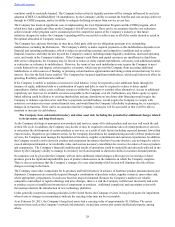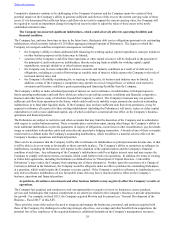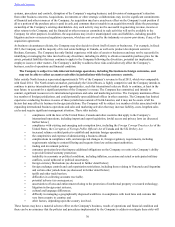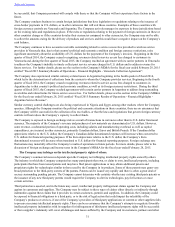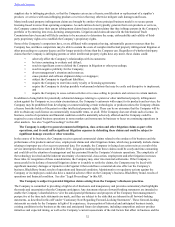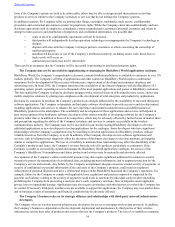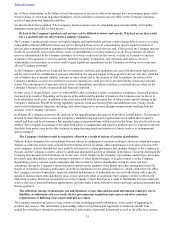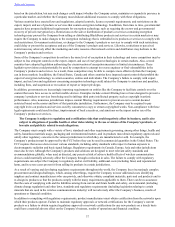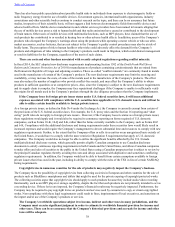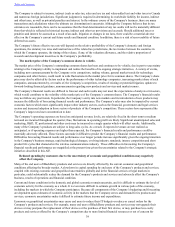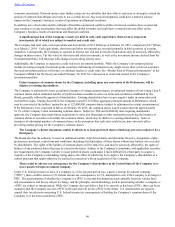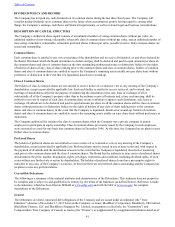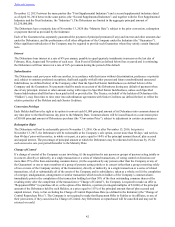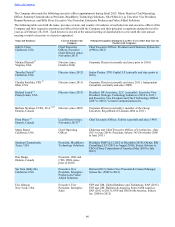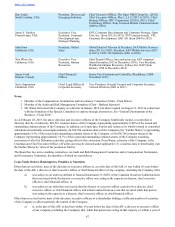Blackberry 2015 Annual Report Download - page 46
Download and view the complete annual report
Please find page 46 of the 2015 Blackberry annual report below. You can navigate through the pages in the report by either clicking on the pages listed below, or by using the keyword search tool below to find specific information within the annual report.
Table of Contents
37
based on the jurisdiction, but any such changes could impact whether the Company enters, maintains or expands its presence in
a particular market, and whether the Company must dedicate additional resources to comply with these obligations.
Various countries have enacted laws and regulations, adopted controls, license or permit requirements, and restrictions on the
export, import, and use of products or services that contain encryption technology. In addition, from time to time, governmental
agencies have proposed additional requirements for encryption technology, such as requiring the escrow and governmental
recovery of private encryption keys. Restrictions on the sale or distribution of products or services containing encryption
technology may prevent the Company from selling or distributing BlackBerry products and services in certain markets or may
require the Company to make changes to the encryption technology that is embedded in its products or services to comply with
such restrictions. Government restrictions, or changes to the Company’s products or services to comply with such restrictions,
could delay or prevent the acceptance and use of the Company’s products and services. Likewise, restrictions or perceived
restrictions may adversely affect the marketing and sales resources that network carriers and distributors may dedicate to the
Company’s products and services.
Some of the Company’s competitors do not have the same level of encryption in their technology and some competitors may be
subject to less stringent controls on the export, import, and use of encryption technologies in certain markets. Also, several
countries have adopted legislation authorizing the circumvention of encryption measures in limited circumstances. These
legislative provisions could potentially be used by competitors to attempt to reverse engineer or find vulnerabilities in the
Company’s products and services. As a result, these competitors may be able to compete more effectively than the Company
can in those markets. In addition, the United States, Canada and other countries have imposed export controls that prohibit the
export of encryption technology to certain countries, entities and individuals. The Company’s failure to comply with export,
import, and use laws and regulations concerning encryption technology could subject the Company to sanctions and penalties,
including fines, and suspension or revocation of export or import privileges.
In addition, governments are increasingly imposing requirements on entities like the Company to facilitate controls over the
content that users have access to on their mobile devices. Examples include content filtering laws or laws designed to prevent a
company’s products or services from being used to infringe third party intellectual property such as copyright in artistic
performances. Also, numerous jurisdictions impose content filtering requirements to prevent access to content deemed
restricted based on the norms and laws of that particular jurisdiction. Furthermore, the Company may be required to pay
copyright levies on products and services used by consumers to copy or stream copyrighted works. Non-compliance with these
legal requirements could result in fines, imprisonment of local executives, and sanctions on the import and/or use of the
Company’s products or services.
The Company is subject to regulation and certification risks that could negatively affect its business, and is also
subject to allegations of possible health or other risks relating to the use or misuse of the Company’s products, or
lawsuits and publicity related to such allegations.
The Company must comply with a variety of laws, standards and other requirements governing, among other things, health and
safety, hazardous materials usage, packaging and environmental matters, and its products must obtain regulatory approvals and
satisfy other regulatory concerns in the various jurisdictions in which they are manufactured or sold. For example, the
Company’s products must be approved by the FCC before they can be used in commercial quantities in the United States. The
FCC requires that access devices meet various standards, including safety standards with respect to human exposure to
electromagnetic radiation and basic signal leakage. Regulatory requirements in Canada, Europe, Asia and other jurisdictions
must also be met. Although the Company’s products and solutions are designed to meet relevant safety standards and
recommendations globally, when used as directed, any perceived risk of adverse health effects of wireless communication
devices could materially adversely affect the Company through a reduction in sales. The failure to comply with regulatory
requirements can subject the Company to regulatory and/or civil liability, additional costs (including fines) and reputational
harm, and in severe cases prevent it from selling its products in certain jurisdictions.
As a result of varying and developing regulatory requirements throughout the world, the Company faces increasingly complex
procurement and design challenges, which, among other things, require the Company to incur additional costs identifying
suppliers and contract manufacturers who can provide, and otherwise obtain, compliant materials, parts and end products and to
re-design its products so that the products comply with the many requirements applicable to them. There can be no assurance
that the costs of complying with and the liabilities arising from current and future health and safety, environmental (including
climate change regulation) and other laws, standards and regulatory requirements (including legislation relating to certain
minerals that are used in the wireless communications industry) will not adversely affect the Company’s business, results of
operations or financial condition.
In addition to complying with regulatory requirements, product manufacturers must obtain certification from the networks upon
which their products operate. Failure to maintain regulatory approvals or network certifications for the Company’s current
products or a failure to obtain required regulatory approvals or network certifications for any new products on a timely basis
could have a material adverse effect on the Company’s business, results of operations and financial condition.



